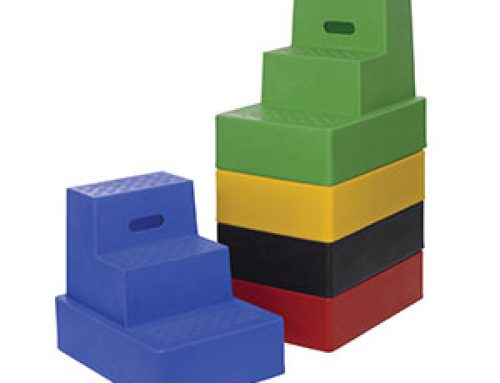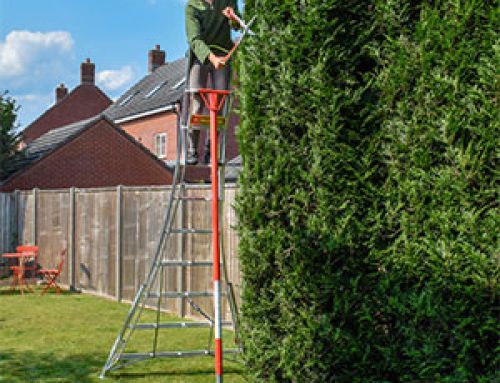A look at different common types of ladders and which are suitable for various tasks
 Before you go ahead and start using a new ladder, you need to make sure you are using the right one for the job. With so many different types of ladders on the market, it is essential to understand what each type is designed for and how to use them safely. To make your job safer and more efficient, check the type of ladder you are planning to use and make sure it is going to be up to the job.
Here is a brief guide on some of the most common types of ladders around to help you make your choice. As well as checking our descriptions here, always check the class of ladder your are buying is suitable for the task you have in mind, and check our guide on the safe use of ladders to make sure you use them responsibly.
Step Ladders
, and it is probably the most common type of ladder in regular use. Step ladders are characterised by their distinctive frame construction, and can be made from wood, aluminium,steel or fibreglass. Because the design lets the ladder support itself, there is no need to lean it against a wall or another type of support to use it. This means they are ideal for using in the middle of a room for changing a lightbulb or out in the garden for trimming low branches off trees.
The two types of step ladders most commonly seen are single sided step ladders or doublesidedstep ladders. The single sided step ladder has rungs on only one side, and the other side is purely for support and not intended to be climbed upon. Double sided step ladders are a more popular choice, particularly in the painting and decorating industry, as they have treads on both sides, allowing the user to climb either side depending on which gives them better access to their work area. Two people can use them at once providing the manufacturer’s safe working load is not exceeded, enabling painting jobs to be done by two workers simultaneously, making them ideal for painting ceilings and high walls in properties or for jobs where two pairs of hands are needed, such as wiring in a new light fitting for example.
The downside of a step ladder is that the height achievable is dependant on the ladder still being safe and stable when unfolded into it’s A frame position. For this reason, step ladders generally have a lower reach than extension ladders and other types of ladders that require additional support, so should only be used for relatively low height jobs. You may find that your step ladder has a platform on the top of it. Don’t be tempted to stand on this, as it is only intended as extra structural support and a handy place to put your paint tin or tools. Proper platform ladders, which can be stood on, will have a guard rail around the platform, and the platform will be of a sturdier construction.
Extension ladders
These types of ladders are typically straight in form and always require supporting on a wall or building to be safe to use.
Rather than unfolding like a step ladder, extension ladders have two or three sections that slide up and down against each other. The main part, also known as the “base”, is the section that stands on the floor, and the moving part, known as the “fly” can slide upwards to extend the reach of the ladder to a greater height. The fly is fixed at its extended level, usually using hooks or a catch of some sort, and ladders can be found with one, two or even more extending sections, enabling the user to reach greater heights.
Extension ladders are most typically used for work at height on the external areas of a property. This can include cleaning windows, clearing gutters and painting the external walls of the house. The most important thing to note when using an extension ladder is that the forces applied by the weight of the user will be greatest at the top of the fly and the bottom of the base. This means that the fly needs to rest against a solid piece of wall, not on a plastic gutter or utility cover, as this could break and cause the ladder to slip.
The other place to take note of is the base, which needs to be on a solid and level piece of ground. Putting it on wet grass, loose gravel or an uneven surface increases the risk of the bottom slipping out of position, or the ladder toppling sideways. If you need to work in an area with unsuitable ground conditions, don’t take risks there are many safety devices you can purchase to make working on uneven or slippery surfaces safer and always ask someone to stand at the bottom of the ladder with one foot on the first rung in order to foot the ladder while you work at the top.
Step stools
A step stool, as the name suggests, is a small, stool height step ladder with treads or steps on one side, allowing the user to climb to moderate heights safely and easily. They are a great choice to have around the house for everyday needs, such as reaching objects on the top shelf in the kitchen cupboards, or getting boxes down from on top of wardrobes. They can also double as a seat or stool, hence the name.
In the majority of houses, this type of ladder is fine for changing light bulbs, and a lot safer than using a chair to stand on. They can also come in handy for painting and decorating, as well as for cleaning the inside of your windows. Because step stools are relatively small types of ladders and generally have the ability to fold flat, they are incredibly convenient to have stored in a cupboard for those times when you really don’t need or want to go out to the garage to get your larger step ladder.
Podium ladders
These ladders are very similar to step ladders, in that they are self supporting structures. They are most typically made from aluminium, but can also be fibreglass. The main difference between these and step ladders is that at the top of a podium ladder, there with a surrounding guardrail, which allows you to safely stand on the top of the ladder to work comfortably for longer periods of time with both hands free. It is important to know whether your ladder is a purpose designed podium ladder, or just a step ladder with a platform. Many step ladders do have a flat platform at the top, but this is purely designed to rest your paint tray or tools on and is not designed for you to stand on.
The main benefit of using a podium ladder is the rest it gives the bottom of your feet. Anyone who has spent some time standing on a step ladder will already know the discomfort that the rungs can cause to the soles of the feet, even through work shoes, and often the shins become sore too from resting on the rung above for support. As well as allowing your legs and feet to get a break, podium ladders give the added advantage of leaving both your hands free to work. This is a big plus for people who are plastering or doing electrical installations, as the job will be done quicker and more safely from a podium ladder with both their hands free to work.
Combination ladders
These ladders have been designed to do the job of two or more of the other types of ladders listed above. The most frequently seen combination ladder is a step ladder and extension ladder in one. Usually made in three sections, the combination ladder can be used as a standard 3-section extension ladder leant against a wall, or opened and locked into an A frame position to act as a self supporting step ladder. One section can be slid up from the other two to make a useable, free standing extension ladder.
Combination ladders are really useful for reaching lights in sports halls or theatres where speedy access to high areas is required replacing expensive and time consuming scaffold towers. Many models can also be utilised for use on stairways. Available in a wide range of sizes, combination ladders are becoming ever more popular with home owners as well as trade and industrial users. Stability is enhanced by the attachment of a wide horizontal stabiliser bar on the bottom ladder section to ensure the ladder cannot topple when used in the freestanding stepladder mode.
As with anything that purports to do two jobs in one, there are sometimes compromises to be made. With some combination ladders, you might find that in the step ladder position, this ladder is a little less stable than a purpose built step ladder. Similarly, you may find the extension ladder doesn’t have quite the reach of one that is designed just for that purpose. And of course, there is often a financial compromise to be made, as combination ladders can be quite expensive. But for many trades the combination ladder is a marvellous, time saving tool, taking the place of several pieces of bulky equipment.
Multipurpose Ladders
As the name suggests, multipurpose ladders are cleverly designed to fold and lock into a variety of shapes and useful configurations, allowing the user to tackle almost any task within the home or workplace. They have become extremely popular over recent years as users strive to purchase an all in one access solution. These ladders are made from 4 short sections of ladder, joined by strong, steel locking hinges which allow the sections to be locked at various angles.
As with combination ladders, wide, horizontal stabiliser bars are fitted to both ends of the ladder to ensure optimum stability when using the ladder in step or scaffold configurations. This type of ladder is often supplied with platform planks or plates which convert the ladder into a convenient mini scaffold, however, care must be taken when using this type of ladder in the scaffold / work platform mode, as there is no provision for any type of handrail.
If you are looking to invest in one adaptable and flexible ladder for general household needs, you won’t go far wrong with a good quality multipurpose ladder. From cleaning the gutters to painting the ceilings, youll find a multipurpose ladder is capable of doing the majority of household tasks safely and efficiently, and because they fold flat when you have finished they are easy to store in a cupboard or shed out of sight.






Leave A Comment
You must be logged in to post a comment.